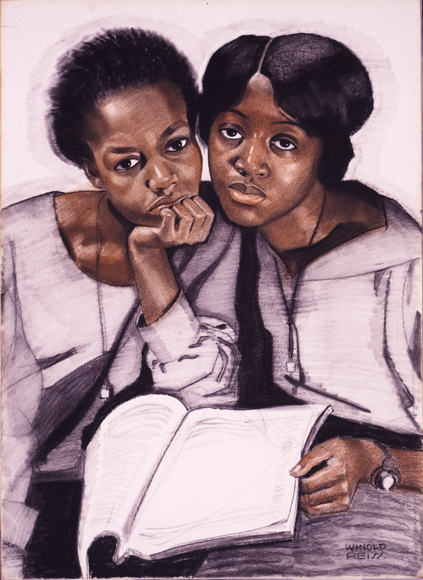Two Public School Teachers

Date: March, 1925
Caption: This painting by Winhold Reiss is titled “Two Public School Teachers.” It was printed in the March 1925 issue of The Survey Graphic, which focused on art and intellectual life in Harlem.

In March 1925, The Survey Graphic published a special issue. The national magazine with a predominantly white readership invited Alain Locke to guest-edit the issue. He wrote that the issue was meant “to document the New Negro culturally and socially,—to register the transformations of the inner and outer life of the Negro in America that have so significantly taken place in the last few years.” The issue explored the origins of jazz and “Negro folk music,” the “inner life of Harlem,” the community’s “organizing social forces,” the neighborhood’s youth, and the conditions of the schools they attended.1
The March 1925 Survey Graphic was not just an analysis of “the New Negro.” It was also an important statement about how Black Harlemites understood themselves and wanted the world to understand them. As Alain Locke made clear, so much public discussion “…is about the Negro rather than of him, so that it is the Negro problem rather than the Negro that is known.” Locke and other contributors made the Survey Graphic special issue an act of “self-portraiture” that “concentrated upon self-expression and the forces and motives of self-determination.”2 Part of that “self-portraiture” was in the term “New Negro” itself, which Alain Locke used to declare a new phase of African American life and leadership that was confident, conscious, capable, and ready to contest the misperceptions of others.
The Survey Graphic issue included several portraits by German immigrant artist Winhold Reiss. This one captures “Two Public School Teachers,” likely Lucile Spence and Melva Price.3 These two teachers advocated for Black history, school integration, improved educational facilities, and more. They saw their role as educators to go beyond teaching core subjects, to include working with their communities for better schooling and a better world.
Given the Survey Graphic issue’s focus on “self expression” and the “motives of self-determination,” this portrait raises interesting questions about how these activist educators chose to present themselves and why they made those choices.
-
Alain Locke, “Forward to The New Negro: An Interpretation,” Survey Graphic 53, no. 11 (March 1925): 629. ↩︎
-
Locke, “Forward to The New Negro,” 629. ↩︎
-
Jeffrey Stewart, “Alain Locke’s Controversial Vision of a ‘Negro Renaissance,’” LitHub, accessed April 19, 2023, https://lithub.com/alain-lockes-controversial-vision-of-a-negro-renaissance/. ↩︎
Categories: K-12 organizing, community activism
Tags: Harlem, teachers unions, photography, imagery, and visual representation, Black people, women's activism
This item is part of "Lucile Spence and Teacher Activism" in "Black and Latina Women’s Educational Activism"
Item Details
Date: March, 1925
Creator: Winhold Reiss
Source: The Reiss Project
Copyright: Public domain
How to cite: “Two Public School Teachers,” Winhold Reiss, in New York City Civil Rights History Project, Accessed: [Month Day, Year], https://nyccivilrightshistory.org/gallery/two-public-school-teachers.
Questions to Consider
- How do Lucille Spence and Melva Price present themselves? How does the portrait artist present the two teachers?
- Why might a portrait of two teachers be included in this issue of the Survey Graphic?
References
How to Print this Page
- Press Ctrl + P or Cmd + P to open the print dialogue window.
- Under settings, choose "display headers and footers" if you want to print page numbers and the web address.
- Embedded PDF files will not print as part of the page. For best printing results, download the PDF and print from Adobe Reader or Preview.
